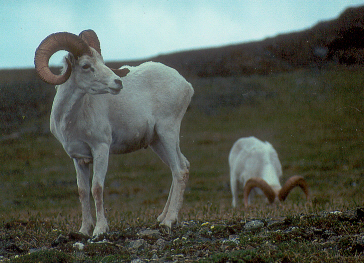Wildflowers do their blooming from late May into August and blooming times can vary depending on elevation, the length of winter, the hospitality of spring, and a variety of other factors.
 The
range of colors is magnificent - from the magenta of
Fireweeds, the violet-blues of Harebells, to the lemon yellow of
Cinquefoils and Arctic Poppy. Wildflowers
of Denali National Park by
Verna and Frank Pratt (1993, AlaskaKrafts) is an excellent guide to the
park's flora, with 410 color plates. Sections include trees found in
the park (alders, willows, birch, aspen and spruce) as well as
mushrooms, lichens and mosses. Plant edibility and even specific
locations of plant life along the 89 mile park road are included.
The
range of colors is magnificent - from the magenta of
Fireweeds, the violet-blues of Harebells, to the lemon yellow of
Cinquefoils and Arctic Poppy. Wildflowers
of Denali National Park by
Verna and Frank Pratt (1993, AlaskaKrafts) is an excellent guide to the
park's flora, with 410 color plates. Sections include trees found in
the park (alders, willows, birch, aspen and spruce) as well as
mushrooms, lichens and mosses. Plant edibility and even specific
locations of plant life along the 89 mile park road are included. Birdlife in Alaska is well-documented and checklists are updated regularly. Denali National Park has recorded over 160 species, with many species nesting during the short summer breeding season, only to migrate late summer and fall. Permanent residents, though few in number, like the Great Gray Owl, Gyrfalcon
 and
ptarmigan, have adapted to the harsh winters and can be seen year
round. A Guide
to the Birds of Alaska by Robert Armstrong
(1995, Alaska Northwest Books) is a handy photographic field reference
for 295 avian species that occur regularly in Alaska. This work
in paperback is small enough to pack and along with a standard field
guide (Peterson, Sibley, and the like) is all one needs to identify
that winged flash in the sky "beyond a shadow of a doubt."
and
ptarmigan, have adapted to the harsh winters and can be seen year
round. A Guide
to the Birds of Alaska by Robert Armstrong
(1995, Alaska Northwest Books) is a handy photographic field reference
for 295 avian species that occur regularly in Alaska. This work
in paperback is small enough to pack and along with a standard field
guide (Peterson, Sibley, and the like) is all one needs to identify
that winged flash in the sky "beyond a shadow of a doubt." The mammals of Denali National Park are year round residents and range in size from the Pygmy shrew - one of the rarest North American mammals at 1/8 of an ounce in weight to the largest deer in the world at over 1000 pounds - the moose. Many of the mammals in the park checklist are fairly common and visible, and a few are more than impressive. The list, which was changed in 2001 - the status of Mountain goat is uncertain, is small enough (37 species) to list below.
- masked shrew

- dusky shrew
- tundra shrew
- pygmy shrew
- little brown bat
- collared pika
- snowshoe hare
- hoary marmot
- arctic ground squirrel
- red squirrel
- northern flying squirrel
- beaver
- porcupine
- muskrat
- northern red-backed vole
- meadow vole
- tundra vole
- yellow-cheeked vole
- singing vole
- brown lemming
- northern bog lemming
- meadow jumping mouse

- coyote
- wolf
- red fox
- black bear
- grizzly (brown) bear
- marten
- short-tailed weasel
- least weasel
- mink
- wolverine
- river otter
- lynx
- moose
- caribou
- Dall sheep
A good photo reference for Alaska's mammals is The Audubon Society Field Guide to North American Mammals by John Whitaker, Jr. (1980, Knopf). It includes a track guide of footprints (that you will encounter in the mudflats and soft sand bars during river crossings). The Peterson A Field Guide to the Mammals is also a good choice for field marks, tracks, and habitat preferences.
Of smaller note, though no less important...as biological indicators of environmental health, amphibians in general and frogs in particular offer us a window through which we can view our own well-being. Healthy frogs are a good sign for us, it seems. Unfortunately Denali National Park has only one recorded species - the wood frog, to help us keep an eye on ourselves and our eco-meddling activities. In fact, it is our only frog found north of the Arctic Circle. To its credit, and its ultimate survivability in such a hostile environment, the wood frog has evolved into an "explosive breeder" for 1 or 2 days in summer before hibernating most of its life away in winter. The fragility of the wood frog's existence typifies an ecosystem that, though enduring, is very fragile indeed.
Our visit to the "crown jewel" of our national park system will treat this fragility with the respect and care it deserves. We can capture moving images on film, we can commit exciting moments to memory, we can realize the fulfillment of our arctic fantasies and dreams. But we will tread lightly and "leave nothing behind but our footsteps." In so doing we help ensure a future that we can be proud of and our grandchildren will thank us for.
The wood frogs will thank us too.